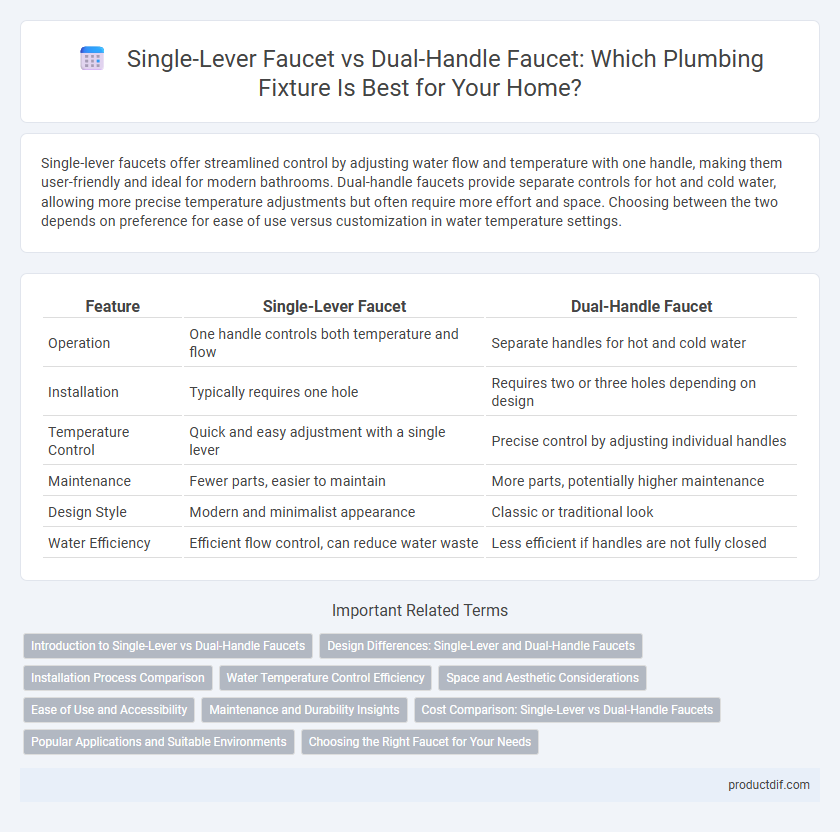Single-lever faucets offer streamlined control by adjusting water flow and temperature with one handle, making them user-friendly and ideal for modern bathrooms. Dual-handle faucets provide separate controls for hot and cold water, allowing more precise temperature adjustments but often require more effort and space. Choosing between the two depends on preference for ease of use versus customization in water temperature settings.
Table of Comparison
| Feature | Single-Lever Faucet | Dual-Handle Faucet |
|---|---|---|
| Operation | One handle controls both temperature and flow | Separate handles for hot and cold water |
| Installation | Typically requires one hole | Requires two or three holes depending on design |
| Temperature Control | Quick and easy adjustment with a single lever | Precise control by adjusting individual handles |
| Maintenance | Fewer parts, easier to maintain | More parts, potentially higher maintenance |
| Design Style | Modern and minimalist appearance | Classic or traditional look |
| Water Efficiency | Efficient flow control, can reduce water waste | Less efficient if handles are not fully closed |
Introduction to Single-Lever vs Dual-Handle Faucets
Single-lever faucets control water temperature and flow with one handle, allowing seamless adjustments and streamlined design, ideal for modern kitchens and bathrooms. Dual-handle faucets feature separate controls for hot and cold water, offering precise temperature regulation preferred in traditional or classic settings. Choosing between single-lever and dual-handle faucets depends on user convenience, aesthetic preference, and installation requirements.
Design Differences: Single-Lever and Dual-Handle Faucets
Single-lever faucets feature a streamlined design with one handle that controls both water temperature and flow, offering a minimalist and modern aesthetic ideal for contemporary bathrooms and kitchens. Dual-handle faucets consist of separate hot and cold handles, providing precise temperature control and a traditional or classic look often favored in vintage or rustic settings. The design differences impact installation complexity, with single-lever models typically requiring fewer holes and easier operation, while dual-handle faucets necessitate multiple mounting points but allow customized temperature adjustments.
Installation Process Comparison
Single-lever faucets typically offer a straightforward installation process with fewer connections and simpler alignment, reducing setup time significantly compared to dual-handle faucets. Dual-handle faucets require separate fittings for hot and cold water lines, increasing complexity and the potential for installation errors. Choosing a single-lever faucet can streamline plumbing setup, especially in retrofit projects or tight spaces.
Water Temperature Control Efficiency
Single-lever faucets provide precise water temperature control by allowing users to adjust hot and cold water with one motion, resulting in faster temperature adjustment and less water waste. Dual-handle faucets require separate manipulation of hot and cold valves, often leading to slower temperature optimization and higher water consumption. The streamlined operation of single-lever faucets enhances water temperature control efficiency in both residential and commercial plumbing applications.
Space and Aesthetic Considerations
Single-lever faucets offer a streamlined design that saves countertop space, making them ideal for compact or modern bathrooms. Dual-handle faucets, with separate hot and cold controls, provide a classic aesthetic and can complement traditional or vintage decor styles. Choosing between these fixtures depends on the desired balance between minimalist space efficiency and decorative visual appeal.
Ease of Use and Accessibility
Single-lever faucets offer superior ease of use and accessibility by allowing users to control water temperature and flow with one simple motion, making them ideal for individuals with limited mobility or dexterity. Dual-handle faucets require separate adjustments for hot and cold water, which can be challenging for those with arthritis or disabilities. The streamlined design of single-lever faucets enhances user experience by providing quick and intuitive control compared to the more complex operation of dual-handle models.
Maintenance and Durability Insights
Single-lever faucets feature fewer moving parts, reducing the likelihood of leaks and simplifying maintenance compared to dual-handle faucets, which require separate repairs for hot and cold controls. The ceramic disc cartridges in single-lever models enhance durability and resist wear better than traditional compression valves often found in dual-handle designs. Regular maintenance of single-lever faucets typically involves less time and cost, making them a practical choice for long-term reliability in plumbing fixtures.
Cost Comparison: Single-Lever vs Dual-Handle Faucets
Single-lever faucets generally feature a higher initial purchase price compared to dual-handle faucets due to their more complex cartridge mechanism and contemporary design. Installation costs for single-lever models tend to be lower, as they require only one hole and simpler plumbing connections, unlike dual-handle faucets which often need multiple holes and more labor-intensive installation. Over time, single-lever faucets may offer cost savings through easier maintenance and reduced water usage thanks to precise temperature and flow control.
Popular Applications and Suitable Environments
Single-lever faucets are popular in modern kitchens and bathrooms due to their ease of use and sleek design, making them ideal for residential and commercial settings with high traffic. Dual-handle faucets are commonly found in traditional or vintage-style bathrooms, offering precise control over water temperature, which suits environments like historic homes and specialized washrooms. Both faucet types accommodate various plumbing systems but are chosen based on aesthetic preference and user convenience.
Choosing the Right Faucet for Your Needs
Single-lever faucets offer streamlined control with one handle to adjust both temperature and flow, making them ideal for modern kitchens and bathrooms where convenience and speed are priorities. Dual-handle faucets provide separate adjustments for hot and cold water, allowing precise temperature control preferred in traditional or classic-style plumbing fixtures. Evaluating daily water usage patterns, design compatibility, and maintenance preferences helps determine the best faucet type for specific household needs.
single-lever faucet vs dual-handle faucet Infographic

 productdif.com
productdif.com